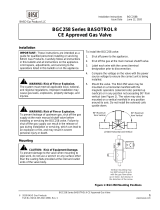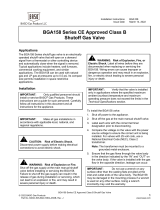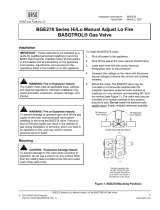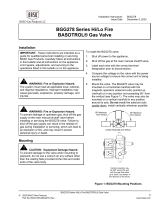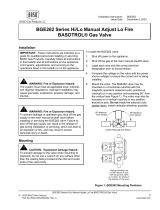Page is loading ...

Installation Instructions BGD258
Issue Date August 22, 2017
BGD258 Series BASOTROL® CE Approved Class A Gas Valve
© 2017 BASO Gas Products 1
Part No. BASO-INS-BGD258, Rev. H www.baso.com
BGD258 Series BASOTROL®
CE Approved Class A Gas Valve
Installation
IMPORTANT: These instructions are intended as a
guide for qualified personnel installing or servicing
BASO Gas Products. Carefully follow all instructions
in this bulletin and all instructions on the appliance.
Limit repairs, adjustments, and servicing to the
operations listed in this bulletin or on the appliance.
!
WARNING: Risk of Fire or Explosion.
The system must meet all applicable local, national,
and regional regulations. Improper installation may
cause gas leaks, explosions, property damage, and
injuries.
!
WARNING: Risk of Fire or Explosion.
To prevent leakage of upstream gas, shut off the gas
supply at the main manual shutoff valve before
installing or servicing the BGD258 valve. Failure to
shut off the gas supply can result in the release of
gas during installation or servicing, which can lead to
an explosion or fire, and may result in severe
personal injury or death.
Mounting
!
CAUTION: Risk of Equipment Damage.
To prevent damage to the valve when mounting to
pipework, do not use a wrench on any surface other
than the casting flats provided at the inlet and outlet
ends of the valve body.
To install the BGD258 valve:
1. Ensure that the specified maximum ambient
(surface) temperature is not exceeded (see the
Technical Data section).
2. Ensure that the power supply voltage is
compatible with the required control valve voltage.
3. Shut off the gas at the main manual shutoff valve.
4. When installing the valve on the manifold, ensure
that the gas flows through the valve body in the
direction indicated by the arrow on the valve body.
If the valve is installed with the gas flow in the
opposite direction of the arrow, leakage can occur.
5. Mount the valve to the pipework. The BGD258
valve may be mounted on a horizontal manifold
with the solenoid coils pointed up (vertical) or in
any position not exceeding 90from the vertical.
The valve also may be mounted on a vertical
manifold in any position around its axis (see
Figure 1). Do not install the solenoid coil upside
down. Install vertically wherever possible.
90° Maximum
from Vertical
90° Maximum
from Vertical
Limited Horizontal and Vertical
Vertical mounting may
be 360º around its axis
with the gas flow either
up or down, but always in
the direction of the arrow.
No
Regulator
Figure 1: BGD258 Valve Mounting Positions

BGD258 Series BASOTROL® CE Approved Class A Gas Valve
© 2017 BASO Gas Products 2
Part No. BASO-INS-BGD258, Rev. H www.baso.com
6. Thread pipe (the amount shown in Table 1) for
insertion into the control. Do not thread the pipe
too far. Valve distortion or malfunction may result if
the pipe is inserted too deeply.
Table 1: NPT Pipe Thread Length Into Valve
Pipe Size
(NPT)
Thread Pipe
Amount (in.)
Maximum Depth
Pipe (in.)
1/2
3/4
1/2
3/4
13/16
3/4
7. For any threaded connections, threads of pipe and
nipples must be smooth and free of tears and
burrs. Steam clean all piping inside diameter to
remove foreign substances such as cutting oil or
thread chips before installing into the valve. Apply
a moderate amount of good quality pipe
compound (do not use Teflon tape) to pipe only,
leaving two end threads bare (see Figure 2). On
LP in use compound resistant to LP gas.
APPLY A MODERATE AMOUNT OF
PIPE COMPOUND TO PIPE ONLY
(LEAVE TWO END THREADS BARE), CAUTION: EXCESSIVE COMPOUND
MAY BLOCK DISC OFF VALVE
SEAT CAUSING LEAKS.
CORRECT WRONG
Figure 2: Use a Moderate Amount
of Pipe Compound
8. Ensure the gas flows through the valve body in the
direction indicated by the arrow on the body. If the
valve is installed with the gas flow in the opposite
direction of the arrow, leakage can occur. Connect
pipe to gas control inlet and outlet. Use a wrench
on the square ends of the control. If a flange is
used, place the wrench on the flange rather than
on the controls. This process should be used
for both the install and removal of the valve in
a gas system (see Figure 5).
9. If you desire to measure the outlet pressure, use
the bottom cast pressure test fitting (see Figure 4)
or use the Y99AX pressure test fitting
(see Figure 3) and an approved pipe joint
compound on the male threads and replace the
marked pressure tap plug, which is optional on the
inlet or outlet of the valve body. Screw the fitting
into threaded port of the valve, which replaces the
pressure tap plug.
Figure 3: Y99AX-1 (1/8-27 NPT) Pressure Test Fitting
Y99AX-2 (1/8-28 BSPT) Pressure Test Fitting
10. Check for leakage before making any valve
adjustments.
a. Shut off the gas at the main manual shutoff
valve and open the pressure connection
between the manual shutoff valve and the
BGD258 valve.
b. Connect air tubing with a maximum pressure
of 1-1/2 times the valve’s maximum operating
pressure (as indicated on the valve) to the
opened pressure connection.
c. Paint all valve body connections with a rich
soap and water solution.
If bubbles occur, this is an indication of a leak.
To stop a leak, tighten joints and connections.
Replace the part if the leak cannot be stopped.
If bubbles do not occur, remove the air tubing
and close the pressure connection.
11. Make wiring connections. Refer to the Wiring
section for specific wiring instructions.
12. Check for leakage at the bleed hole. Paint the
bleed hole with a rich soap and water solution (or
use acceptable gas leak detection equipment). If
bubbles occur, this is an indication of a gas leak.
To stop a leak, tighten the needle screw. Replace
the valve if the leak cannot be stopped.
13. Observe at least three complete operating cycles
to ensure that all components are functioning
correctly before leaving the installation.
Outlet Pressure
Tap Connection
Figure 4: Underside of Valve

BGD258 Series BASOTROL® CE Approved Class A Gas Valve
© 2017 BASO Gas Products 3
Part No. BASO-INS-BGD258, Rev. H www.baso.com
APPLY WRENCH TO THE FLATS
FROM THE TOP OR BOTTOM
OF THE GAS CONTROL VALVE
APPLY WRENCH
TO FLATS ONLY
Figure 5: Proper Use of Wrench on Gas Control

BGD258 Series BASOTROL® CE Approved Class A Gas Valve
© 2017 BASO Gas Products 4
Part No. BASO-INS-BGD258, Rev. H www.baso.com
Wiring
!
WARNING: Risk of Electrical Shock.
Disconnect the power supply before making
electrical connections to avoid electrical shock or
equipment damage. Ensure that the operating
voltage is identical to the information on the product
identification label.
The BGD258 valve is supplied with 3-tab or 2-tab
electrical connections. The solenoid coils are male
tabs and electrical connections should be made using
6.35 x 0.8 mm (1/4 in.) female, fully insulated push-on
terminals. The earth ground is clearly labeled.
The electrical wiring to a twin solenoid valve from an
electronic intermittent proven pilot ignition system is
comprised of two lines; a common and an independent
earth ground. Wiring can be done using a single 4-wire
cable. The wiring connections for a 4-wire cable are
shown in Figure 6.
Route the electrical cable for the valve solenoid from
the burner sequence control to the valve and make
wiring connections in accordance with Figure 6.
Note: Electrical connections can also be made using
electrical plugs (DIN 43650 Form B [ISO 4400]).
Available from a BASO Gas Products distributor.
Note: All wiring must be in accordance with national
and local electrical codes and regulations.
Setup and Adjustments
Checkout
!
WARNING: Risk of Fire or Explosion.
Follow this or an equivalent checkout procedure
after installation. Before leaving the installation,
verify that the gas valve functions properly and that
the system has no gas leaks. Gas leaks can lead to
an explosion or fire, and may result in severe
personal injury or death.
IMPORTANT: All adjustments must be made in
conjunction with the gas appliance and in
accordance with the appliance manufacturer’s
instructions. Only authorized personnel should make
adjustments.
!
WARNING: Risk of Fire or Explosion.
The minimum flow rate of the valve must not be
adjusted below the minimum safe working rate of the
appliance. This may cause gas leaks, which can
lead to an explosion or fire and may result in severe
personal injury or death.
Make sure all components are functioning properly by
performing the following test:
1. Test all joints and connections for leaks with a
soap solution.
2. Close the main upstream shutoff valve and wait at
least 5 minutes for unburned gas to escape from
the appliance, and then reopen the shutoff valve.
3. Turn on the main electrical power switch and close
the thermostat contacts. The appliance should operate
in accordance with the manufacturer’s specified
sequence of operation.
4. Turn the thermostat to a low dial setting to open
the contacts. All burner flames should be extinguished.
Repeat Steps 3 and 4 at least three times.
5. Return the thermostat to a normal setting before
leaving the installation.
Repairs and Replacement
Table 2: Replacement Solenoid Coil
Part Number
Description
RSDA16A-12
12 VDC; 2-tab 15 VA Coil
RSDA16A-25
25 VAC; 50/60 Hz; 3-tab 15 VA Coil
RSDA16A-25V
25 VDC; 3-tab 17 VA Coil
RSDA16A-120
120 VAC; 50/60 Hz; 3-tab 15 VA Coil
RSDA16A-240
240 VAC; 50/60 Hz; 3-tab 15 VA Coil
Field repairs other than solenoid coil replacement
must not be made to the BGD258 valve.
Any attempt to repair this assembly voids the
manufacturer’s warranty. For a replacement valve,
contact the original equipment manufacturer or the
nearest BASO Gas Products distributor.

BGD258 Series BASOTROL® CE Approved Class A Gas Valve
© 2017 BASO Gas Products 5
Part No. BASO-INS-BGD258, Rev. H www.baso.com
L
N
LN
Non-Polarity Sensitive
Line and Neutral
Connections
Non-Polarity Sensitive
Line and Neutral
Connections
To Main Solenoid To Pilot Solenoid
L2
N2
N1
L1
Coil 2
Main
Valve
Coil 1
Pilot
Valve
Earth Ground
Line 2
Neutral
Line 1
Twin Solenoid Wiring Using 4-Wire Cable
Ground Tab
25V, 120V and 240V Only
Ground Tab
25V, 120V and 240V Only
Figure 6: 3-Tab Electrical Connections

BGD258 Series BASOTROL® CE Approved Class A Gas Valve
© 2017 BASO Gas Products 6
Part No. BASO-INS-BGD258, Rev. H www.baso.com
Technical Specifications
Product
BGD258 Series BASOTROL CE Approved Class A Gas Valve
Types of Gas
2nd (Natural Gas), and 3rd (LP Gas) Family Gases
Permissible Ambient
(Surface)
Temperature
-29 to 79°C (-20 to 175°F)
Electrical Ratings
12 VDC, 1.0A
25 VDC, 0.675A
25 VAC, 50/60 Hz, 0.595A
120 VAC, 50/60 Hz, 0.13A
240 VAC, 50/60 Hz, 0.063A
Rated Inlet Pressure
North America:
Europe:
Australia:
2 psi
138 mbar
13.8 kPa
Maximum Working
Pressure (CE)
138 mbar
Reverse Pressure
Ratings
150 mbar (15 kPa [60 in. W.C.]) Class A (EN 161); Class 1 (AS 4629)
Body Connections
3/8 or 1/2 NPT, 3/8 or 1/2 BSPP (Thread ISO 7-Rp), 3/8 or 1/2 BSPT (Thread ISO 7-Rc)
with Flange Connection Holes (M4 x 0.7 mm pitch x 6 mm deep)
Valve Torsion Group
Group 2 (EN 161)
Pressure Connection
1/8 BSPP (Thread ISO 7-Rp), 1/8 BSPT (Thread ISO 7-Rc),
1/8 NPT Left-hand and/or Right-hand, or M5 x 0.8 Thread Bottom
Pilot Connections
1/8 BSPP (Thread ISO 7-Rp), 1/8 BSPT (Thread ISO 7-Rc),
1/8 NPT Left-hand and/or Right-hand or 1/4 in. cc Fitting Bottom
Dirt Strainer
0.9 mm (0.036 in.) Mesh (CE only or upon request)
Operating Time
Rating
100% Continuous
Valve Timings
Closing Time
Opening Time
Dead Time
<1 Second
<1 Second
<1 Second
Power Ratings
15 VA per Coil (except 25 VDC, 17 VA)
Electrical
Connections
3-Tab Solenoid Coil
2-Tab Solenoid Coil
2 x 6.35 mm (1/4 in) + 6.35 mm (1/4 in) Earth Ground
2 x 6.35 mm (1/4 in)
Coil Insulation Class
Class F
Packaging
Bulk pack supplied to original equipment manufacturer (individual pack optional).
Bulk Pack Quantity
30 per carton
Bulk Pack Weight
35 kg (77 lb) per carton

BGD258 Series BASOTROL® CE Approved Class A Gas Valve
© 2017 BASO Gas Products 7
Part No. BASO-INS-BGD258, Rev. H www.baso.com
Technical Specifications (continued)
Agency Listings
CSA (AGA/CGA) Certificate Number 229521-1656041
EC Type Examination Certificate Number EC-86/10/062
UL File Number MH5939
Australian Gas Association Certificate Number 7934
Specification
Standards
EN 161
Standards Complying with EMC Directive
Standards Complying with Low Voltage Directive
Australian Standard AS 4629
ANSI Standard Z21.21
Canadian Standard CSA 6.5
UL Standard 429
Performance specifications are nominal and conform to acceptable industry standards. All agency certification of BASO products is performed
under dry and controlled indoor environmental conditions. Use of BASO products beyond these conditions is not recommended and may void
the warranty. Product must be protected if exposed to water (dripping, spraying, rain, etc.) or other harsh environments. The original
equipment manufacturer or end user is responsible for the correct application of BASO products. Consult BASO Gas Products LLC for
questionable applications. BASO Gas Products LLC shall not be liable for damages or product malfunctions resulting from misapplication or
misuse of its products.
Refer to the BGD258 Series CE Approved Gas Valve Product Bulletin (BASO-PB-BGD258) for necessary information on operating and
performance specifications of this product.
450 East Horseshoe Road
PO Box 170
Watertown, WI 53094 www.baso.com
1-877-227-6427 (1-877-BASOGAS) Printed in U.S.A.
/

